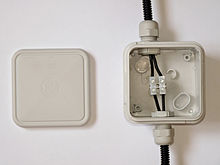Cables
Armoured cables with two rubber-insulated conductors in a flexible metal sheath were used as early as 1906, and were considered at the time a better method than open knob-and-tube wiring, although much more expensive.
The first polymer-insulated cables for building wiring were introduced in 1922. These were two or more solid copper electrical wires with rubber insulation, plus woven cotton cloth over each conductor for protection of the insulation, with an overall woven jacket, usually impregnated with tar as a protection from moisture. Waxed paper was used as a filler and separator.
Over time, rubber-insulated cables become brittle because of exposure to atmospheric oxygen, so they must be handled with care, and are usually replaced during renovations. When switches, outlets or light fixtures are replaced, the mere act of tightening connections may cause hardened insulation to flake off the conductors. Rubber insulation further inside the cable often is in better condition than the insulation exposed at connections, due to reduced exposure to oxygen.
Rubber insulation was hard to strip from bare copper, so copper was tinned, causing slightly more electrical resistance. Rubber insulation is no longer used for permanent wiring installations, but may still be used for replaceable temporary cables where flexibility is important, such as electrical extension cords.
About 1950, PVC insulation and jackets were introduced, especially for residential wiring. About the same time, single conductors with a thinner PVC insulation and a thin nylon jacket (e.g. US Type THN, THHN, etc.) became common.
The simplest form of cable has two insulated conductors twisted together to form a unit; such unjacketed cables with two or three conductors are used for low-voltage signal and control applications such as doorbell wiring. In North American practice, an overhead cable from a transformer on a power pole to a residential electrical service consists of three twisted (triplexed) wires, often with one being a bare wire made of copper (protective earth/ground) and the other two being insulated for the line voltage (hot/live wire and neutral wire). For additional safety, the ground wire may be formed into a stranded co-axial layer completely surrounding the phase conductors, so that the outmost conductor is grounded.
[edit]Copper conductors
Main article: Copper wire and cable
Electrical devices often contain copper conductors because of their multiple beneficial properties, including their high electrical conductivity, tensile strength, ductility, creepresistance, corrosion resistance, thermal conductivity, coefficient of thermal expansion, solderability, resistance to electrical overloads, compatibility with electrical insulators, and ease of installation.
Despite competition from other materials, copper remains the preferred electrical conductor in nearly all categories of electrical wiring.[8][9] For example, copper is used to conduct electricity in high, medium and low voltage power networks, including power generation, power transmission, power distribution, telecommunications, electronicscircuitry, data processing, instrumentation, appliances, entertainment systems, motors, transformers, heavy industrial machinery, and countless other types of electrical equipment.[10]
[edit]Aluminium conductors
Aluminium wire was common in North American residential wiring from the late 1960s to mid 1970s due to the rising cost of copper. Because of its greater resistivity, aluminium wiring requires larger conductors than copper. For instance, instead of 14 AWG (American wire gauge) for most lighting circuits, aluminium wiring would be 12 AWG on a typical 15 ampere circuit, though local building codes may vary.
Aluminium conductors were originally indiscriminately used with wiring devices intended for copper conductors. This practice was found to cause defective connections unless the aluminium was one of a special alloy, or all devices — breakers, switches, receptacles, splice connectors, wire nuts, etc. — were specially designed for the purpose. These special designs address problems with junctions between dissimilar metals, oxidation on metal surfaces, and mechanical effects that occur as different metals expand at different rates with increases in temperature.
Unlike copper, aluminium has a tendency to cold-flow under pressure, so screw clamped connections may get loose over time. This can be mitigated by using spring-loaded connectors that apply constant pressure, applying high pressure cold joints in splices and termination fittings, and torquing the bolted connection.[further explanation needed]
Also unlike copper, aluminium forms an insulating oxide layer on the surface. This is sometimes addressed by coating aluminium wires with an antioxidant paste at joints, or by applying a mechanical termination designed to break through the oxide layer during installation.
Because of improper design and installation, some junctions to wiring devices would overheat under heavy current load, and cause fires. Revised standards for wiring devices (such as the CO/ALR "copper-aluminium-revised" designation) were developed to reduce these problems. Nonetheless, aluminium wiring for residential use has acquired a poor reputation and has fallen out of favour.
Aluminium conductors are still used for bulk power distribution and large feeder circuits, because they cost less than copper wiring, and weigh less, especially in the large sizes needed for heavy current loads. Aluminium conductors must be installed with compatible connectors.



No comments:
Post a Comment